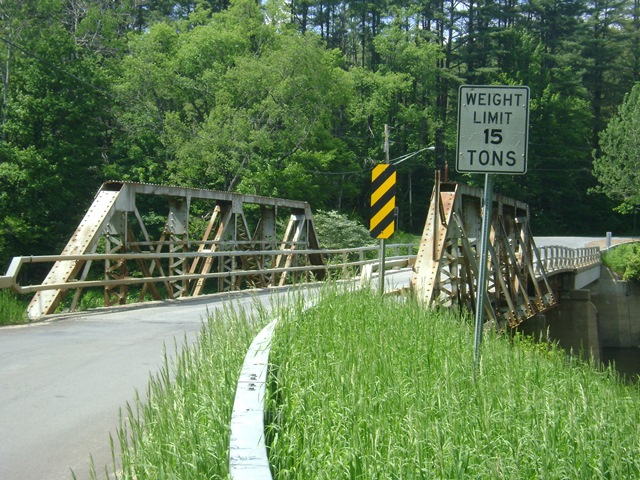We Recommend:
Bach Steel - Experts at historic truss bridge restoration.
BridgeHunter.com Phase 1 is released to the public! - Visit Now
Harvey Bridge

Primary Photographer(s): Marc Scotti
Bridge Documented: June 6, 2011
Not Available or Not Applicable
85.0 Feet (25.9 Meters)
248.0 Feet (75.6 Meters)
16 Feet (4.88 Meters)
1 Main Span(s) and 2 Approach Span(s)
2204740

View Information About HSR Ratings
Bridge Documentation
This single span riveted truss bridge has approach spans that appear to be replacements, suggesting this may have been originally a multi-span truss bridge.
The bridge has three spans of different designs, which is not unheard of for rural towns with tiny budgets. One would assume pony truss was original, because the West Canada Creek would have been narrower when it was built. Just a few miles downstream, Hicnkley Lake was built to supply water for the summit of the New York State Barge Canal, around 1910-15. So it would seem logical that the other spans were added at the time the dam was constructed, however the spans do not look quite that old. There are also built-up truss members buried in the weeds used as posts and such suggesting a truss might have been demolished. In any case, it seems likely that there may have been additional truss spans here at one time and that the bridge seen today looks nothing like it did originally. Further confusion comes from the National Bridge Inventory which gives an 1895 construction date, which while possible, is rather early for a rivet-connected truss bridge.
As seen today the bridge is configured as follows. There is only one truss span at the southern end of the bridge. North of this span is the middle span. It consists of a steel stringer span of unusual design. It consists of four steel beams spanning from pier to pier. Underneath each beam, a second shallower beam is welded on the bottom, with a taper at each end, giving the beams a fishbelly appearance. This unusual design is most likely to accomodate the challenges of replacing a pony truss span (superstructure above deck) with a stringer span (superstructure below deck). To get the depth of section in a stringer bridge needed to support a truss-length span, while also not changing the height of the deck, this fishbelly design provides the section where it is needed at the center, while allowing the superstructure to bear on the piers without increasing deck height.
The northernmost span consists of a prestressed concrete adjacent box beam span. Its use of pre-stressed concrete indicates it must date to the 1950s or later.
View Archived National Bridge Inventory Report - Has Additional Details and Evaluation
This bridge is tagged with the following special condition(s): Unorganized Photos
![]()
Photo Galleries and Videos: Harvey Bridge
Unorganized Photos
Original / Full Size PhotosA collection of overview and detail photos, presented as an unorganized and unlabeled collage and gallery. This gallery offers photos in the highest available resolution and file size in a touch-friendly popup viewer.
Alternatively, Browse Without Using Viewer
![]()
Unorganized Photos
Mobile Optimized PhotosA collection of overview and detail photos, presented as an unorganized and unlabeled collage and gallery. This gallery features data-friendly, fast-loading photos in a touch-friendly popup viewer.
Alternatively, Browse Without Using Viewer
![]()
Maps and Links: Harvey Bridge
Coordinates (Latitude, Longitude):
Search For Additional Bridge Listings:
Bridgehunter.com: View listed bridges within 0.5 miles (0.8 kilometers) of this bridge.
Bridgehunter.com: View listed bridges within 10 miles (16 kilometers) of this bridge.
Additional Maps:
Google Streetview (If Available)
GeoHack (Additional Links and Coordinates)
Apple Maps (Via DuckDuckGo Search)
Apple Maps (Apple devices only)
Android: Open Location In Your Map or GPS App
Flickr Gallery (Find Nearby Photos)
Wikimedia Commons (Find Nearby Photos)
Directions Via Sygic For Android
Directions Via Sygic For iOS and Android Dolphin Browser
USGS National Map (United States Only)
Historical USGS Topo Maps (United States Only)
Historic Aerials (United States Only)
CalTopo Maps (United States Only)

